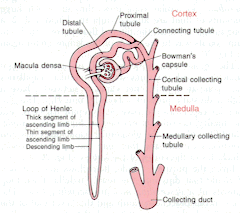|
|
Anesthesia Pharmacology: Renal Pharmacology
Diuretics: Antihypertensive properties
Two main classes of diuretics are used in mangement of hypertension: thiazides and potassium sparing drugs.
Objective: pharmacological alteration of sodium load.
A reduction in sodium leads to reduced intravascular volume and a blood pressure reduction.
Thiazide diuretics cause an inhibition of NaCl transport in the Distal Convoluted Tubule (DCT).
 |
|
![]() Orally
active thiazide drugs have
historically been a mainstay of antihypertensive
treatment, although present therapy often involves other
drugs.
Orally
active thiazide drugs have
historically been a mainstay of antihypertensive
treatment, although present therapy often involves other
drugs.
|
Note the progression of antihypertensive medication;
|
|
Reduction in blood pressure is initially due to a reduction in extracellular volume and cardiac output.
Long-term antihypertensive effects of thiazides appear due to reduced vascular resistance. The exact mechanism responsible for the reduction in vascular resistance is not known.
Thiazides, due to their inhibition of the Na+-Cl- symport system, increase sodium and chloride excretion.
|
|
|
Thiazide diuretics, when used in the management of hypertension, is administered in combination with a potassium-sparing drug.
Reduction in the amount of potassium loss can be achieved by:
Using potassium sparing drugs block Na+ channels in the late distal tubule and collecting duct (amiloride (Midamor) and triamterene (Dyrenium))
|
|
|
Inhibition of aldosterone action (spironolactone (Aldactone):
|
|
|
Jackson, E.K. Diuretics In, Goodman and Gillman's The Pharmacological Basis of Therapeutics, (Hardman, J.G, Limbird, L.E, Molinoff, P.B., Ruddon, R.W, and Gilman, A.G.,eds) The McGraw-Hill Companies, Inc.,1996, pp. 685- 713
Jackson, E.K. Vasopressin and Other Agents Affecting the Renal Conservation of Water In, Goodman and Gillman's The Pharmacological Basis of Therapeutics,(Hardman, J.G, Limbird, L.E, Molinoff, P.B., Ruddon, R.W, and Gilman, A.G.,eds) The McGraw-Hill Companies, Inc.,1996, pp.715-732
|
This Web-based pharmacology and disease-based integrated teaching site is based on reference materials, that are believed reliable and consistent with standards accepted at the time of development. Possibility of human error and on-going research and development in medical sciences do not allow assurance that the information contained herein is in every respect accurate or complete. Users should confirm the information contained herein with other sources. This site should only be considered as a teaching aid for undergraduate and graduate biomedical education and is intended only as a teaching site. Information contained here should not be used for patient management and should not be used as a substitute for consultation with practicing medical professionals. Users of this website should check the product information sheet included in the package of any drug they plan to administer to be certain that the information contained in this site is accurate and that changes have not been made in the recommended dose or in the contraindications for administration. Advertisements that appear on this site are not reviewed for content accuracy and it is the responsibility of users of this website to make individual assessments concerning this information. Medical or other information thus obtained should not be used as a substitute for consultation with practicing medical or scientific or other professionals. |